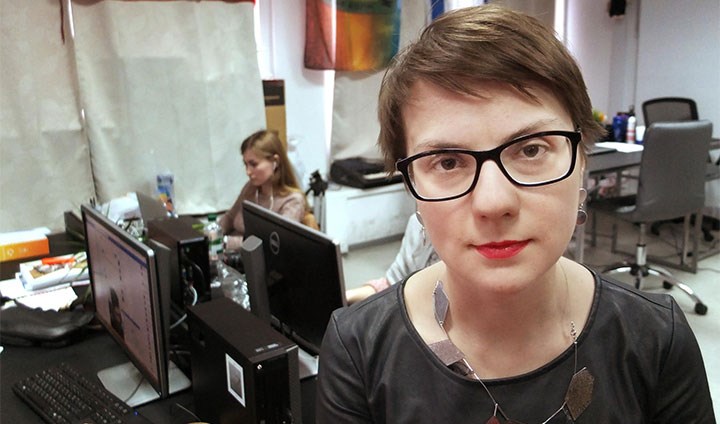Nataliya Gumenyuk revolutionised news in Ukraine

The twelfth floor of a high-rise in central Kiev is where Hromadske TV has its office. As Ukraine’s first independent TV station it played a prominent role during the protests on the Maidan Square; events that unfolded in late 2013.
Name: Nataliya Gumenyuk
Lives in: Kiev, Ukraine
Profession: Journalist and director
Qualification: MA in Global Journalism, 2006, Örebro University
Nataliya Gumenyuk is co-founder of Hromadske. She is currently head of the station and is also overseeing the international news broadcasts in English and Russian. 2005–2006 she was a student on the Master’s programme in Global Journalism at Örebro University.
We have a peek into the studio during a broadcast. Young journalists, looking very trendy, discuss the events of the day. We take a seat in a sound studio doubling as storage.
Hromadske was set up by a dozen Ukraine investigative journalists, Nataliya Gumenyuk tells me.
“We wanted to create an independent TV station, providing quality journalism. Up until that point, there had been no such thing in Ukraine. We wanted to do online TV broadcasts as it would be more cost-efficient.”
Revolution in the streets
Not long after broadcasting started, the protests on the Maidan Square began. The protests led to the president at the time, Viktor Yanukovych, leaving the country a few months later. The revolution was a fact.
“During the Maidan protests, it was evident that there really was a need for a station like ours. Before we began our broadcasts, live reporting was non-existent in Ukraine. On TV, there was only the 8 o’clock news. Can you see why people were watching us? There was a revolution going on in the streets, and the only broadcast news was on at 8 at night,” says Nataliya Gumenyuk.
Following the revolution, she reported on events during the Russian annexation of Crimea. She has also reported on the war in eastern Ukraine. By then, Nataliya Gumenyuk was used to working in conflict zones.
After graduating from Örebro, she worked as a foreign correspondent on TV. She has worked in some 50 countries in the Middle East and the Caucasus region, but also in Europe.
A year ago, she published the book Maidan Tahrir. In Search of the Lost Revolution, where she compares the situation in countries like Tunisia and Egypt after the Arab Spring with that in Ukraine following Maidan.
“I see many similarities. What is essential is that the civil society remains strong even after the revolution. Only then can there be a true change in power.”
Fighting censorship
She is very happy with her studies at Örebro University.
“It was a very international set-up. I had fellow students from countries like Indonesia, Yemen and Chile. It helped widen my perspective and made me more open-minded. This was soon after the invasion of Iraq and we looked at how uncritical American media was in their reporting. In Western Europe, there are those who claim that we in the Ukraine take an uncritical stance towards NATO and the US, but I also recognise the mistakes made by American media. It was part of my training.”
The media in Ukraine has changed since Hromadske began their broadcasts, according to Nataliya Gumenyuk, but, she claims, it is still under political control. However, Hromadske’s toughest competitor these days is entertainment.
“Before, we were fighting censorship. Now we increasingly have to compete with commercial and populist media. It is difficult to sell a story that perhaps not everybody wants to hear. But this is a challenge everywhere, not just in Ukraine. How do you reach a large audience with quality journalism?” concludes Nataliya Gumenyuk.
Text and photo: David Isaksson
Translation: Charlotta Hambre-Knight
